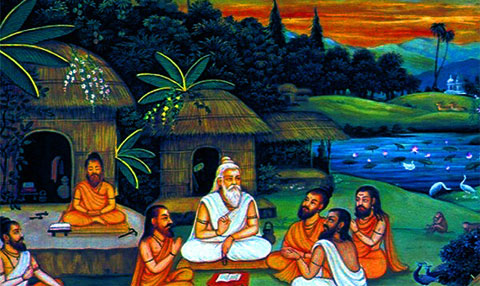This education system began in ancient times during the Vedic age when there was no particular form of formal education but the learning was skill-based.Embark on a captivating exploration of the Gurukul system, a profound paradigm of education that flourished during the Vedic age in ancient India. Rooted in discipline, holistic learning, and the sacred bond between teacher and student, this page delves into the enduring principles that continue to inspire modern educational thought.
Features Of Gurukul

Holistic Learning:
Education extended beyond the academic realm, embracing a holistic approach that encompassed professional, social, religious, and spiritual dimensions.

Selection Based on Character:
The cornerstone of student enrollment lay in an impeccable attitude and moral strength, showcasing the emphasis on character building.

Practical Skills:
In addition to traditional subjects, students were imparted practical skills, equipping them for diverse tasks and real-world challenges.

Psychological Teaching Method:
The Gurukul system employed a psychological approach to teaching, fostering not just knowledge acquisition but the all-around development of individuals.
Aim Of Gurukul
Holistic Development:
The primary objective was to nurture the comprehensive growth of individuals, transcending mere academic achievements.
Personality Growth:
The Gurukul system aimed at molding personalities through a combination of education and character development.
Spiritual Awakening:
It sought to cultivate a profound connection with spiritual dimensions, fostering a deeper understanding of life.
Awareness about Nature and Society:
Students were educated about the intricacies of the natural world and societal norms, promoting a well-rounded worldview.
Knowledge and Culture Transmission:
One of the key goals was to pass on knowledge and cultural values through successive generations, ensuring continuity.
Some Renowned Ancient University
Takshashila University
The ancient University of Taxila, renowned for its Brahmanical and later Buddhist teachings, stood as a prominent center of higher learning in the city of Taxila. While references fixating its inception emerged a millennium later, it is believed to have roots dating back to at least the fifth century BC, with some scholars asserting its existence from the sixth century BC. Unlike traditional educational institutions, Taxila comprised several monasteries without substantial dormitories or lecture halls, suggesting that religious instruction was likely delivered on an individualistic basis.
The detailed accounts of Takshashila are found in Jātaka tales written around the fifth century AD in Sri Lanka. Flourishing as a distinguished learning hub for several centuries BC, Taxila continued to attract students until the city’s demise in the fifth century AD.
Noteworthy educators at the University of Taxila included Pāṇini, the eminent 5th-century BCE Indian grammarian, Chanakya, the influential Prime Minister of Chandragupta Maurya, the founder of the Mauryan Empire, and Kumāralāta, credited as the founder of the Sautrāntika school according to the accounts of Chinese Buddhist monk Yuan Chwang in the 3rd century.
Among the significant students were King Pasenadi of Kosala, a close friend of Buddha, Jivaka, the court doctor at Rajagriha and personal physician of Buddha, and Charaka, hailed as the “father of medicine” in Indian tradition and a leading authority in Ayurveda.
The legendary Chandragupta Maurya, the future founder of the Mauryan Empire, received his training and education at Taxila under the guidance of Chanakya. The accounts state that he studied “all the sciences and arts” of the period, including military sciences, during his eight years at the university. This aligns with Greek and Hindu texts, affirming that Kautilya (Chanakya) hailed from the northwest Indian subcontinent, and Chandragupta was his resident student for eight years. These narratives also resonate with Plutarch’s claim that Alexander the Great encountered the young Chandragupta during his campaign in the Punjab.

Nalanda University
Nalanda, an ancient center of higher learning in Bihar, India, thrived as a Buddhist hub from 427 to 1197 CE. Revered as “one of the first great universities in recorded history,” its roots trace back to Emperor Ashoka the Great. At its peak, it drew scholars from China, Greece, and Persia.
The library of Nalanda, Dharma Gunj, housed an extensive collection that burned for months when Muslim invaders sacked the university in 1193. In a modern initiative, countries collaborated in 2006 to restore Nalanda as Nalanda International University.
Historical Significance:
Founded in the 5th Century BC, Nalanda was one of the world’s earliest universities, visited by Buddha during his lifetime. Its zenith in the 7th century saw 10,000 students and 2,000 teachers.
Libraries:
Dharma Gunj, the library, held the “Mountain of Truth” or “Treasury of Truth” and was tragically destroyed during the invasion.
Curriculum:
Nalanda’s curriculum spanned Buddhist and Hindu studies, science, astronomy, medicine, logic, metaphysics, and more.
Ruins:
The extensive ruins, covering 150,000 square meters, include the Surya Mandir, a nearby Hindu temple. Efforts to understand Nalanda’s legacy persist through institutions like Nava Nalanda Mahavihara.
Nalanda, once a beacon of knowledge, stands as a testament to the ebb and flow of history.


